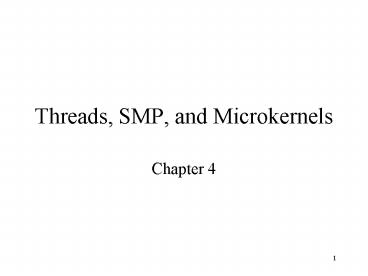Threads, SMP, and Microkernels PowerPoint PPT Presentation
Title: Threads, SMP, and Microkernels
1
Threads, SMP, and Microkernels
- Chapter 4
2
Process
- Resource ownership - process has an address
space, controls devices and files - Scheduling/execution- process follows an
execution path and has a current execution
status - These two characteristics can be treated
independently by the operating system allowing
3
Multithreading
- Operating system supports multiple threads of
execution within a single process - Process level resource ownership
- Thread level execution status
- For example
- MS-DOS supports one process with one thread
- UNIX supports multiple user processes but only
supports one thread per process - Windows, Solaris, Linux, Mach, and OS/2 support
multiple threads per process
4
(No Transcript)
5
Thread
- An execution state (running, ready, etc.)
- Saved thread context when not running
- Has an execution stack
- Some per-thread static storage for local
variables - Access to the memory and resources of its process
- all threads of a process share this
6
(No Transcript)
7
Benefits of Threads
- Takes less time to create a new thread than a
process - Less time to terminate a thread than a process
- Less time to switch between two threads within
the same process - Since threads within the same process share
memory and files, they can communicate with each
other without invoking the kernel
8
Thread Management
- Suspending a process involves suspending all
threads of the process since all threads share
the same address space - Termination of a process, terminates all threads
within the process
9
Thread States
- Operations associated with a change in thread
state - Spawn
- Spawn another thread
- Block
- Unblock
- Finish
- Deallocate register context and stacks
10
User-Level Threads
- All thread management is done by the application
- The kernel is not aware of the existence of
threads
11
Kernel-Level Threads
- Windows is an example of this approach
- Kernel maintains context information for the
process and the threads - Scheduling is done on a thread basis
12
Categories of Computer Systems
- Single Instruction Single Data (SISD) stream
- Single processor executes a single instruction
stream to operate on data stored in a single
memory - Single Instruction Multiple Data (SIMD) stream
- Each instruction is executed on a different set
of data by the different processors
13
Categories of Computer Systems
- Multiple Instruction Single Data (MISD) stream
- A sequence of data is transmitted to a set of
processors, each of which executes a different
instruction sequence. Never implemented - Multiple Instruction Multiple Data (MIMD)
- A set of processors simultaneously execute
different instruction sequences on different data
sets
14
(No Transcript)
15
(No Transcript)
16
Microkernels
- Small operating system core
- Contains only essential core operating systems
functions - Many services traditionally included in the
operating system are now external subsystems - Device drivers
- File systems
- Virtual memory manager
- Windowing system
- Security services
17
(No Transcript)
18
Benefits of a Microkernel Organization
- Uniform interface on request made by a process
- Dont distinguish between system-level and
user-level services - All services are provided by means of message
passing - Extensibility
- Allows the addition of new services
- Flexibility
- New features added
- Existing features can be subtracted
19
Benefits of a Microkernel Organization
- Portability
- Changes needed to port the system to a new
processor is changed in the microkernel - not in
the other services - Reliability
- Modular design
- Small microkernel can be rigorously tested
20
Benefits of Microkernel Organization
- Distributed system support
- Message are sent without knowing what the target
machine is - Object-oriented operating system
- Components are objects with clearly defined
interfaces that can be interconnected to form
software

